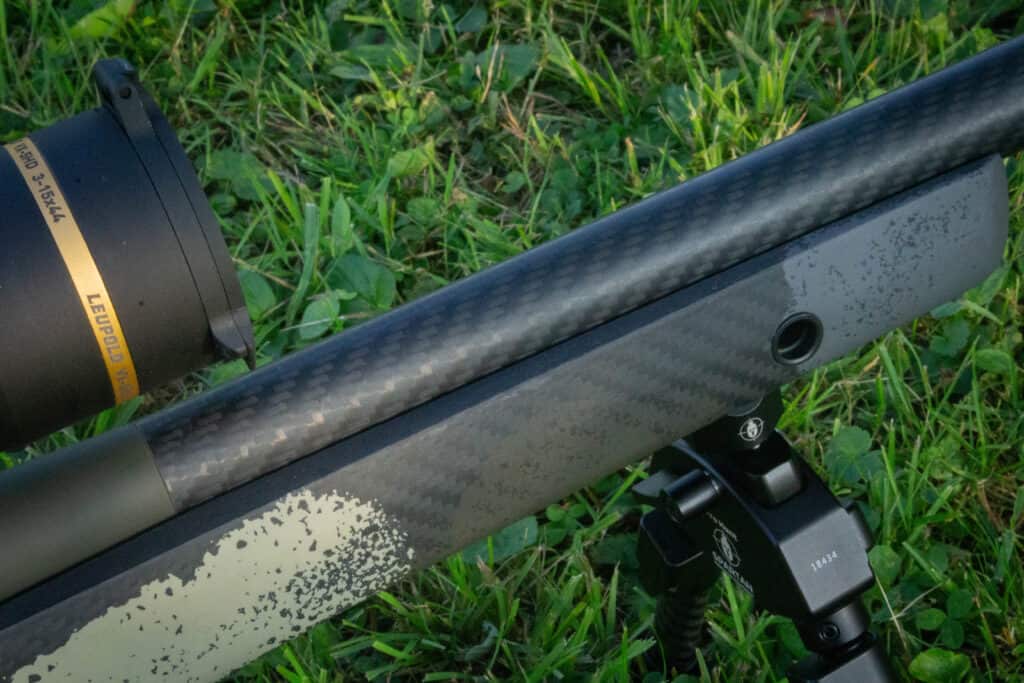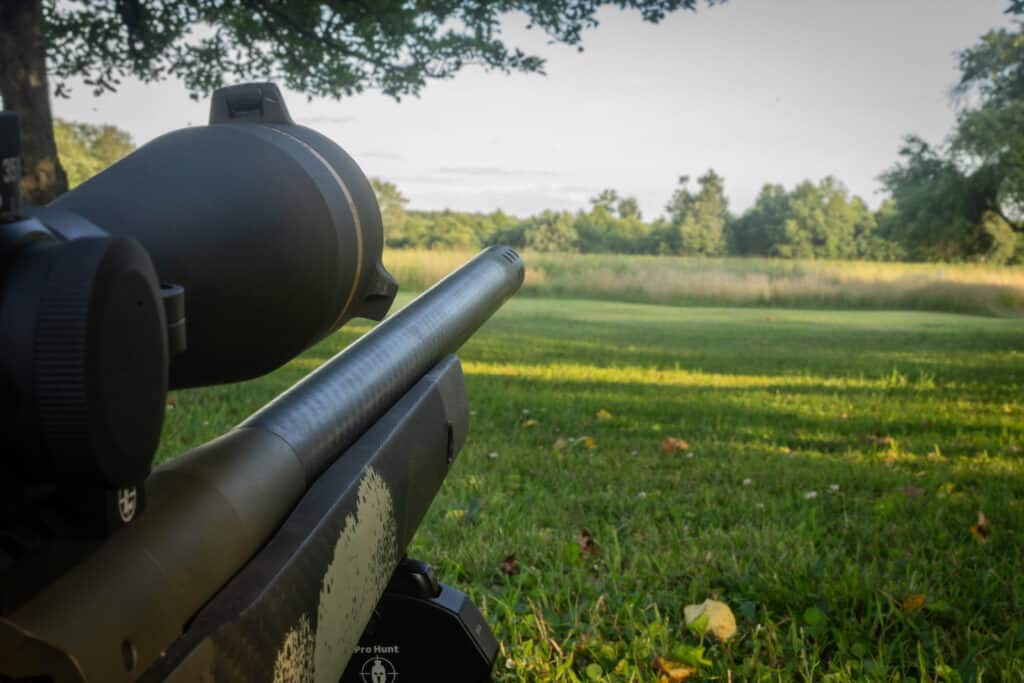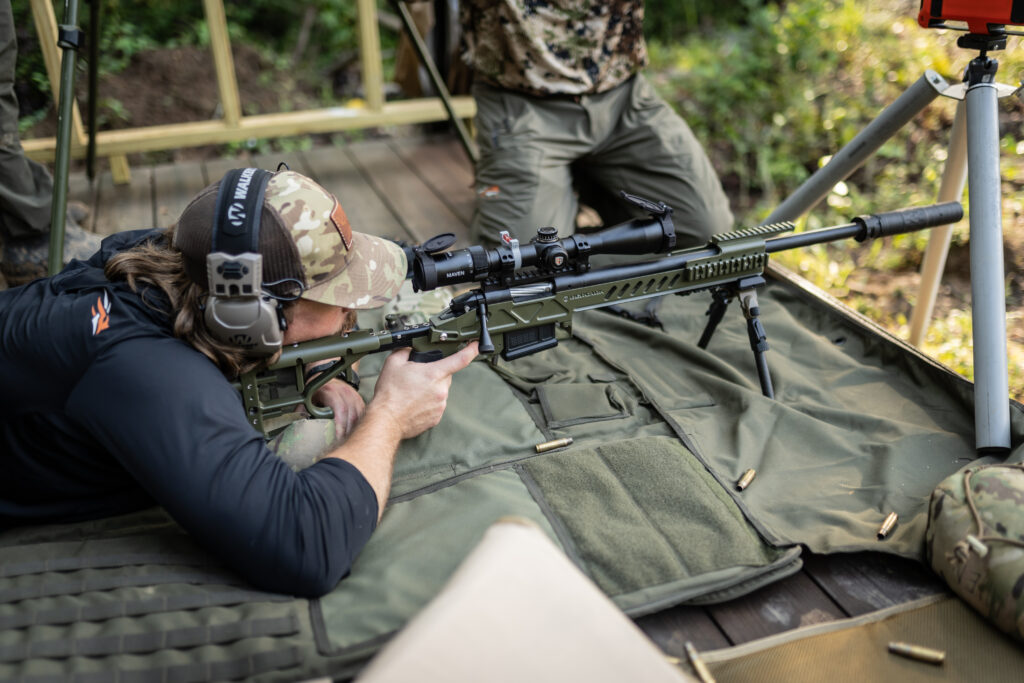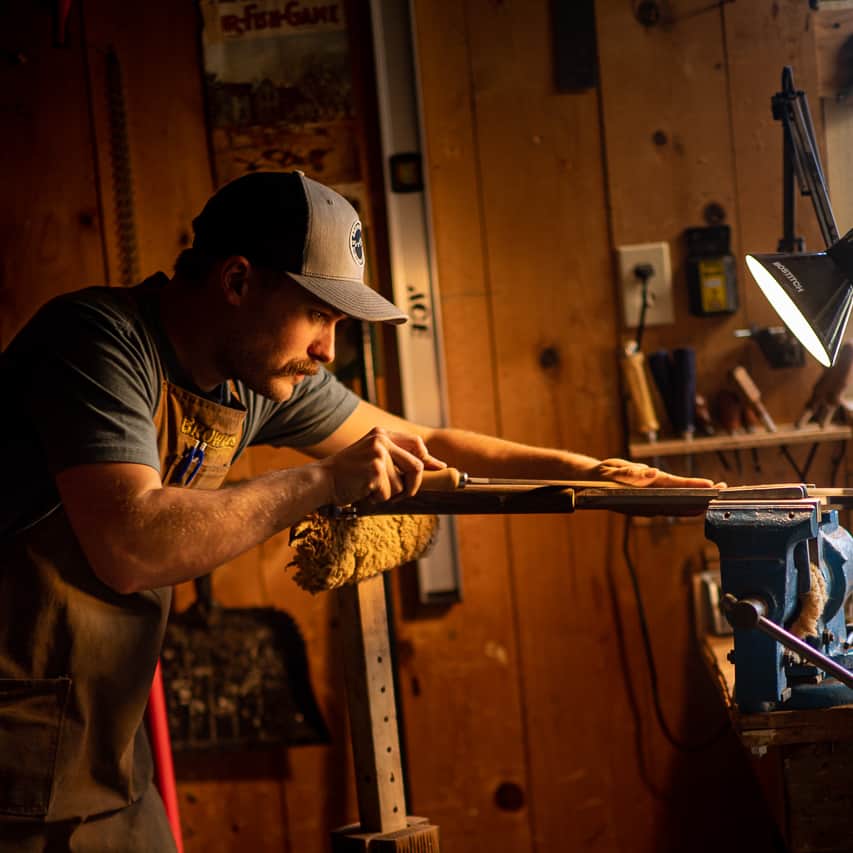
My first experience with a carbon fiber barrel was during my time at the Colorado School of Trades gunsmithing school. Some of the other students at the school were fitting these crazy things to actions making super lightweight rifles. I had never seen anything like it. What was wrong with the traditional barrel?
The carbon fiber barrel is a really lightweight profile stainless steel rifle barrel wrapped in carbon fiber to add rigidity and reduce weight. They are inherently accurate, shed heat quickly, and show no point-of-impact shift during long shot strings. All of this comes at a price. They are very expensive.
This technology is relatively new to the firearms industry, but it is growing fast. New carbon fiber barrel manufacturers are popping up every year as the demand increases. We, the consumers, are finally seeing all the benefits, as well as the drawbacks, these barrels have.
Affiliate Disclosure: This article may contain affiliate links. When you use these links, I earn a small commission from each sale generated at no cost to you. This commission helps me continue to put out free content. I work a full-time job that I am very happy with; therefore, I don’t need this commission and am not obligated to speak highly of any product. Everything written is my own opinion: the good, the bad, and the ugly.
- Carbon Fiber Barrel Construction
- The Benefits of Carbon Fiber Barrels
- The Downsides of the Carbon Fiber Barrel
- List of Carbon Fiber Barrel Manufacturers
- Are They Worth the Hype?
Carbon Fiber Barrel Construction
Believe it or not, the carbon fiber barrel isn’t all that different from the standard rifle barrel that has been made for the last 100 or so years. They aren’t made completely of carbon fiber. Instead, they are made by wrapping an extremely lightweight barrel in carbon fiber to get the necessary rigidity and stiffness needed to make an accurate rifle barrel.
At the core, the carbon fiber barrel is made the exact same as any other barrel. In extremely simple terms, steel is drilled, honed, rifled, and lapped. When this process is complete, you have your basic barrel blank. Next, the barrel is profiled to the desired diameter and taper. While the process is technically the same, this is where the carbon fiber barrel is a little different.
Use coupon code KTG10 to get 10% off your order of $150 or more at Brownells.
The steel profile is the exact same at both ends of the barrel. The shank, where the chamber is cut, and the muzzle are steel. In between is where they cut the weight. They turn the profile down to as lightweight as safely possible, making it somewhat resemble a barbell. That middle section is then wrapped in carbon fiber and resin, as shown in the above video.
At this point, once the resin is dry, the barrel is turned and profiled to the desired thickness and taper. It is then sanded to create the smooth surface that you are used to seeing. The barrel is then threaded and chambered to fit whatever rifle it is going on.

The Benefits of Carbon Fiber Barrels
Now that we have a basic understanding as to how they are made, let’s dive into the benefits of a carbon fiber barrel.
Carbon Fiber Barrel Weight Savings
It is no secret that carbon fiber barrels save weight, but how much? According to Proof Research, a leading carbon fiber barrel manufacturer, the weight savings can be up to 64%. This answer isn’t as straightforward as I’d like it to be. There are so many other factors that play into it that it is impossible to list them all, but I will try.
Weight savings is definitely one of the top reasons people are barreling their rifles with expensive carbon fiber. In the backpack/mountain-hunting world that I’m most familiar with, the cost per ounce of weight savings is often mentioned when discussing a new piece of lightweight gear. It’s no secret that these are expensive, so how much weight are we actually saving?
It depends.
As you’d expect, barrel dimensions play a major part in this equation. As we mentioned earlier, the barrels aren’t 100% carbon fiber, so the savings aren’t linear. They still have that stainless steel inner piece that is wrapped. Therefore, the heavier the barrel profile, the more weight savings compared to a steel equivalent. This also goes for length. Comparatively speaking, a carbon fiber barrel will save a lot more weight on a 26-inch barrel than it will on a 16-inch equivalent.
While Proof Research advertises up to 64% weight savings, I find that the average is closer to 30-50%. Depending on your setup, that can be a lot. For the SIG Cross, the carbon fiber barrel that I looked at weighed 44 ounces and would save me about 4 ounces, while also adding 2″ of barrel for more velocity and a heavier profile barrel. In other words, the $833.99 barrel would cost me approximately $208 per ounce of weight savings, definitely not cheap. However, that isn’t the only reason people are moving to carbon fiber barrels.

Accuracy Expectations
Let’s talk about accuracy. Obviously, no one wants to spend their hard-earned money on a barrel that is going to shoot like shit. Are carbon fiber barrels accurate? Carbon fiber barrels tend to be very accurate but aren’t any more accurate than a premium-made steel barrel. This will vary from manufacturer to manufacturer.
I wish I could tell you how they are so much more accurate than a steel barrel, I can’t. Proof Research markets “Match-grade accuracy,” and I fully believe them on that as I have seen some pretty great groups shot with them. But those groups weren’t any better than the best shots I’ve seen with other match-grade barrels.
I’m not trying to come off as a hater of carbon fiber barrels. I actually really like them. I just haven’t seen any large increase in accuracy in them over what you can get out of a standard barrel. So, this should not be a selling point for you unless you are upgrading a factory barrel.
Everything above was in reference to shooting your standard grouping at the range. One place you will see some accuracy advantages is when shooting long shot strings. For those unfamiliar, that means taking shot after shot and getting the barrel hot. Groups tend to start spreading and even shifting when a barrel gets hot. Carbon fiber barrels improved heat dissipation, reducing this effect and leading to a higher level of accuracy in this scenario. That is probably one of the reasons carbon fiber is so popular in rifle competitions, where a lot of rounds are going down range.
Improved Heat Dissipation
Carbon Fiber barrels do dissipate heat better than full steel barrels. The advantages here are really only seen by those shooting long-shot strings that get barrels hot. For the hunter, this really isn’t a huge factor. However, for the competition shooter, this is a huge advantage as their point of impact shift will be greatly reduced.
Some of you may be unfamiliar with the effect barrel heat plays on your point of impact. Seen primarily with lighter-weight barrels, your impact will start to shift as the barrel warms up. Every rifle is different. Fortunately, this is pretty easy to test yourself. Shoot a shot string one after another without letting your barrel cool down. Slowly, you will watch your groups begin to grow. With high-velocity cartridges and really lightweight sporter barrels, you can begin to see this shift in as little as three shots.
“The carbon fibers we use have a unique ability to diffuse heat along the length of the barrel (much like fiber optics transmit light). Carbon fiber also moves heat very effectively through the wall (thickness) of the barrel greatly increasing heat transport resulting in barrels that cool faster, maintain accuracy over longer sessions of fire, and live longer.”
-Proof Research
Unfortunately, this is a very hard one to test, and since there are so many variables attached to getting quantifiable results, we’ll have to take the manufacturer’s word for it.

Running Suppressors
Carbon fiber barrels are great for running suppressors as the increased barrel diameter lends to a larger shoulder for a suppressor to mate against. If you were to thread a featherweight rifle barrel of the same weight as a carbon fiber barrel, you would be really cutting it close. The shoulders on these rifles are usually just barely enough for a suppressor to secure against. If running a muzzle brake, this isn’t that much of an issue.
Also, the increased stiffness of carbon fiber barrels reduces the point of impact shift that you get when you screw a suppressor to the end of your barrel. It will still shift your point of impact a little bit, but it is typically less. Keep in mind that I am comparing similar-weight barrels here, not similar profiles. A stainless steel bull barrel would likely have similar results but with the increased weight penalty.
The point of impact shift found when adding a suppressor is caused by the changing harmonics in the barrel. The harmonics are small vibrations that occur as a bullet travels down the bore of a barrel. When the weight of a suppressor is added, those harmonics change. The stiffer the barrel, the less harmonic shift you are going to see as a result.

The Downsides of the Carbon Fiber Barrel
While carbon fibers do have a lot of advantages, they also have their drawbacks. The most obvious one is cost. They typically run double the price of a standard barrel and are commonly found in the $700-$1000 range. In many cases, that may cost more than the rifle itself. You have to look at the advantages that I mentioned previously and come to your own conclusions on whether it is worth it to you or not.
If you use my discount code “KTG10” at Brownells.com, you can save 10% on most of the carbon fiber barrels that they carry, helping alleviate some of the heavy price tag.
The next downside to the carbon fiber barrel is that it can be very manufacturer-dependent. Wrapping a steel barrel in carbon fiber does induce some stress on that steel. Stress usually means inconsistent shots. This isn’t just for carbon-wrapped barrels, either. A fluted barrel can have the same issues if your gunsmith isn’t familiar with that process. You need to do your research to find which manufacturer will work the best for you. Some have been in the game longer than others, lending them to have more consistent barrels with each run.
List of Carbon Fiber Barrel Manufacturers
Below is a list of carbon fiber barrel manufacturers. My goal is to make this a complete list. If you notice any manufacturers are missing, please send me an email at kurt@kurtthegunsmith.com, and I will add them.
| Bartlein Barrels, Inc |
| Bergara (Coming Soon) |
| BSF Barrels |
| Carbon Six |
| Christensen Arms |
| Helix 6 Precision |
| Hells Canyon Armory LLC |
| International Barrels |
| Proof Research |
| Snowy Mountain Rifle Company |
| Volquartsen |
Are They Worth the Hype?
Whether carbon fiber barrels are worth the hype or not is completely opinion-based. I’m impartial to the discussion as I think they work great in some applications, like saving every possible ounce, and aren’t the best choice for others. Weight savings is the primary benefit of these barrels, in my opinion. If you are going the carbon fiber barrel route, you also need to look at every aspect of your rifle build to get the most weight savings: the stock, the action itself, the bottom metal, the scope, and the scope mounts.
Carbon fibers are steadily making their way into factory rifle offerings and are really hitting the market hard. A lot of the manufacturers have done much of the work for you. The new Springfield Model 2020 Waypoint series is pretty awesome. It’s a super lightweight setup that drives tacks on the range. My buddy recently picked one up and loves it! However, if weight is your only concern, the Kimber 84M Mountain Ascent still weighs more than a pound less! But how will its lightweight barrel shoot after three consecutive shots? Will it still hold groups?
These are all things to consider. Lastly, there is nothing wrong with just wanting one because. If you’re curious and have the money, why not?
For those of you that do have carbon fiber barrels, let me know your experiences in the comments!

Written by: Kurt Martonik
Kurt is a Gunsmith, Reloader, Hunter, and Outdoorsman. He grew up in Elk County, Pennsylvania, where he became obsessed with the world of firearms. Following high school, Kurt enlisted in the United States Air Force as a Boom Operator, where he eventually rose to the position of Instructor. After his military service, he attended the Colorado School of Trades(CST) in Lakewood, CO for gunsmithing. Following graduation, he accepted a job at C. Sharps Arms in Montana, where he worked as a full time stockmaker and gunsmith.